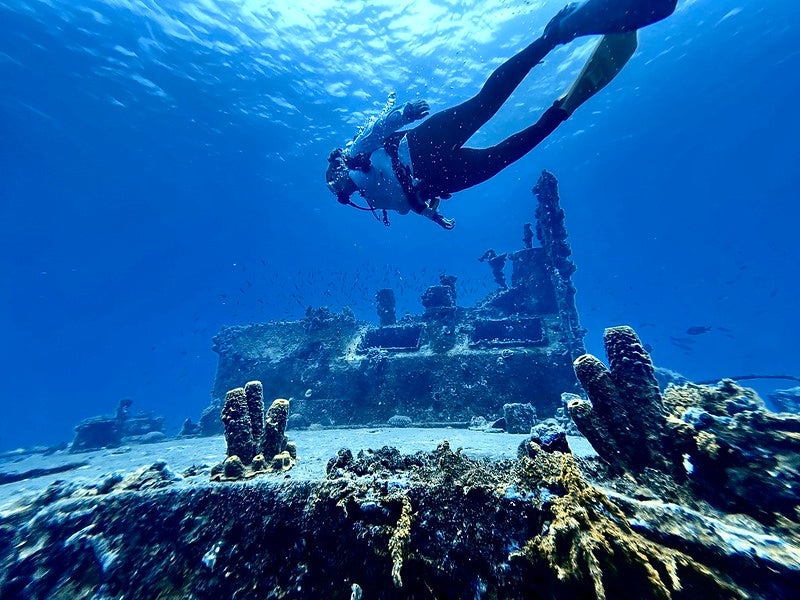There’s something surreal about dropping below the surface and coming face-to-hull with a sunken ship. Some wrecks are time capsules—warships lost in battle, cargo vessels swallowed by storms, or relics of world events frozen in saltwater silence. Others were sunk on purpose, transformed into artificial reefs that give marine life a fresh start.
Whether you’re a seasoned wreck junkie or just dipping your fins into the world of underwater history, here are the best wreck diving destinations on the planet. Each one brings something different to the table—and every one is worth the trip.
Truk Lagoon, Micronesia

This place is the Holy Grail for wreck divers. Over 60 Japanese ships were sunk during Operation Hailstone in 1944, and they’re still sitting there—cargo holds full of tanks, trucks, and gas masks, now covered in soft coral. Warm water, crystal visibility, and layers of war history make Truk a must-dive destination for those willing to make the long journey there.
Best Time to Dive: December–April (dry season)
Top Wrecks: Fujikawa Maru, Shinkoku Maru, San Francisco Maru
Oahu, Hawaii, USA

Oahu is a wreck diver’s playground: sunken Navy ships, WWII aircraft, and even an airplane graveyard—all scattered near volcanic slopes and turquoise seas. It’s where tropical chill meets historical thrill. Many of the wrecks are easily accessible and teeming with marine life, making it a perfect blend of adventure and laid-back island diving.
Best Time to Dive: Year-round (but calmer seas in summer)
Top Wrecks: YO-257, Sea Tiger, Corsair plane wreck
Vanuatu

The SS President Coolidge is an absolute beast—over 650 feet of sunken luxury turned troop transport. You can swim through ballrooms, chandeliers, and even find the famous “Lady” statue. Add in nearby Million Dollar Point (where the U.S. dumped tons of gear post-WWII), and you’ve got a wreck diver’s dream with serious tropical vibes.
Best Time to Dive: May–October
Top Wrecks: President Coolidge, Million Dollar Point vehicles
Florida Keys, USA

The Florida Keys' “Wreck Trek” stretches from Key Largo to Key West with sunken naval ships, artificial reefs, and even the USNS Gen. Hoyt S. Vandenberg, a 520-foot missile-tracking ship. From the depths, divers have the chance to see hundreds of species of fish, sharks, eels, goliath grouper, and much more. Diving in the Florida Keys means warm water, easy access, and plenty of tiki bars when you surface.
Best Time to Dive: April–September
Top Wrecks: Spiegel Grove, USNS Vandenberg, Duane
Solomon Islands

Less crowded than Truk, but just as historic. These waters are full of sunken Japanese and American ships, planes, and submarines from WWII—most totally overtaken by marine life. It's the sweet spot between war stories and pristine coral.
Best Time to Dive: May–November
Top Wrecks: Kinugawa Maru, USS Aaron Ward, multiple aircraft wrecks
Grenada

Grenada is home to more than 15 diveable wrecks, earning its reputation as the wreck diving capital of the Caribbean. At the heart of it all lies the Bianca C—a 600-foot sunken cruise liner often called the "Titanic of the Caribbean." These wrecks are scattered along vibrant reef systems, offering the best of both worlds: deepwater exploration and coral-covered structures teeming with marine life.
Best Time to Dive: December–May
Top Wrecks: Bianca C, Hema I, Shakem
North Carolina, USA

Nicknamed the “Graveyard of the Atlantic,” this stretch of North Carolina coastline is home to over 2,000 shipwrecks, many dating back to World War II and earlier. Treacherous currents and shifting shoals have claimed vessels for centuries, turning the seafloor into a living museum. Today, these wrecks host an abundance of marine life—from sand tiger sharks to barracuda and vibrant schools of fish—creating a wild mix of history and biodiversity.
Best Time to Dive: June–October
Top Wrecks: U-352, Caribsea, Aeolus
Egypt (Red Sea)

The Red Sea delivers wrecks and reefs—like the iconic Thistlegorm, loaded with motorbikes and rifles, surrounded by dazzling soft coral and schools of fish. It’s wreck diving in full color, plus you get camels and desert sunsets topside. With warm water, excellent visibility, and a mix of history and vibrant marine life, it’s one of the most photogenic dive destinations on the planet.
Best Time to Dive: March–May or September–November
Top Wrecks: SS Thistlegorm, Giannis D, Carnatic
Bikini Atoll, Marshall Islands

Few places are as remote—or as wild—as Bikini Atoll. After U.S. nuclear tests in the 1940s and ’50s, a fleet of warships—including battleships and an aircraft carrier—was left to rest in deep, crystal-clear Pacific waters. Now a UNESCO World Heritage Site, Bikini offers one of the most surreal and historically powerful wreck diving experiences on Earth. It’s advanced diving only, but for those who make the journey, it’s nothing short of legendary.
Best Time to Dive: May–September (liveaboard season)
Top Wrecks: USS Saratoga, HIJMS Nagato, USS Arkansas
Bali & Gili Islands, Indonesia

Indonesia is best known for reefs, but don’t sleep on the wrecks. The USAT Liberty in Tulamben is one of the most famous wrecks in the world—easy shore access, vibrant marine life, and sunrise dives with bumphead parrotfish.
Best Time to Dive: April–October
Top Wrecks: USAT Liberty, Japanese patrol boat (Gili Trawangan)

Whether steeped in history or built for rebirth, every wreck tells a story. These ten destinations offer a little bit of everything—history, biodiversity, mystery, and adventure. So zip up that wetsuit, pack your dive log, and start ticking off this list. And hey—don’t forget your Grateful Diver UV long sleeve shirts, neck gaiters, and hats. Sunburns and salt rash? Not cool.
A portion of each purchase goes to Reef Relief's efforts to save and protect the reef. See you on the water!

